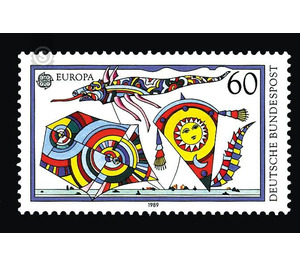Europe - Germany / Federal Republic of Germany 1989 - 60 Pfennig
Theme: Post & Philately
| Country | Germany / Federal Republic of Germany |
| Issue Date | 1989 |
| Face Value | 60.00 |
| Color | multi-colored white |
| Perforation | K 14 |
| Printing Type | Six-color offset printing |
| Stamp Type | Postage stamp |
| Item Type | Stamp |
| Chronological Issue Number | 1290 |
| Chronological Chapter | GER-BRD |
| SID | 294969 |
| In 68 Wishlists | |
The European Conference of Postal and Telecommunications Administrations (CEPT) has, within the framework of the XII. Nice Plenary Assembly in Nice as a common theme for the 1989 European brands »Children's Games«. It was recommended and preferred to give preference to games or toys that are older but still used or used by the children today. Under this general theme, the two European brands of Deutsche Bundespost show "kite flying" and "puppet theater". Earliest traditions report that the Chinese general Han Hsin 1964. He used a dragon to measure the distance to an enemy camp, so he knew how long he would have to dig a tunnel to get there. This probably first kite was made of bamboo, plaited leaves, grasses and bark. The use of paper for the production of such aircraft has come a long time after the invention of the paper in China in 105 AD. In the 10./11. In the 19th century, kite flying in China and Japan became more and more of a recreational activity, and this quickly spread to the neighboring countries of India, Malaysia and Polynesia. After the emergence of the Malaysian, rhombic fighting kite and its transformation into the curved shape in Europe, he became a popular game of knights in the 14th century. The first reports of a serious occupation with the dragon appeared in the 18th century. In Scotland, France, Italy and North America experiments were simultaneously carried out at the time to dissipate electricity from the atmosphere. The American Benjamin Franklin succeeded in 1752 for the first time to derive a lightning by rod antennas on a diamond-shaped dragon to the earth, with which the lightning rod was invented. In addition to the playful kite flying, which is sometimes reflected in paintings of the 17th and 18th centuries, the competitions are still relevant today. While the constructions and functions have changed throughout the centuries in the Western world, the simple European battle dragon has been made up of two crossed sticks, and the kite flying tradition of the Eastern kind is still an important ritual component of daily life. Apart from the building material, the forms and characteristics of the Asian, z. T. very decorative dragon, compared to the original hardly changed. Most common is the game with the diamond-shaped fighting kite. He is small and very manoeuvrable and is usually flown directly from the house roof throughout the Far East. Every year, on certain festive days, dragon battles are fought, with an attempt being made to rip the enemy's leash with the broken glass.


